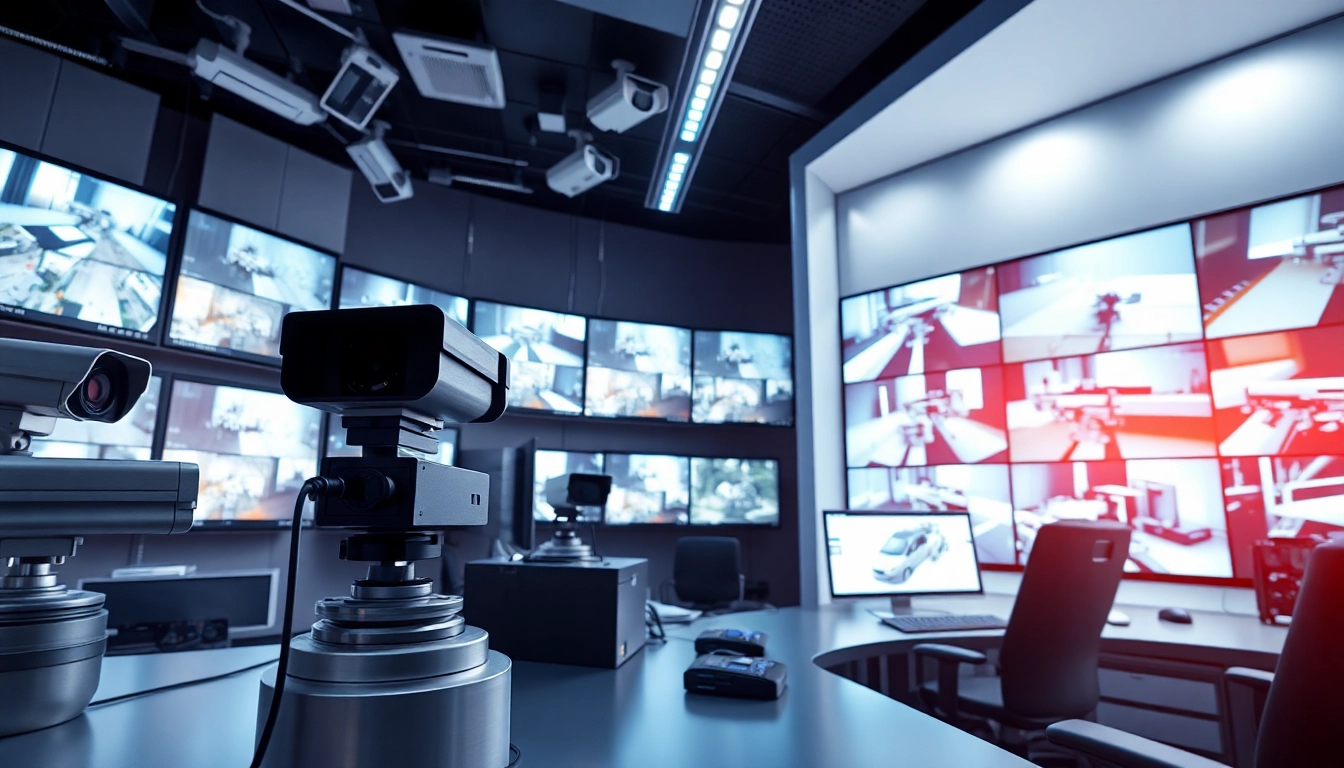Understanding CCTV & Remote Monitoring
What is CCTV & Remote Monitoring?
Closed-Circuit Television (CCTV) & Remote Monitoring represents a pivotal advancement in modern security solutions. At its core, CCTV refers to a system of connected cameras that transmit footage to a specific location for surveillance and monitoring. Remote monitoring enhances this concept by allowing users to access CCTV feeds from anywhere in the world through an internet connection. This technology is not merely about watching over properties; it is about leveraging digital innovations to maintain security round the clock. With the rapid growth of threats to safety and property, implementing a system that includes CCTV & Remote Monitoring has become more crucial than ever.
The Technology Behind CCTV & Remote Monitoring
The technological backbone of CCTV & Remote Monitoring consists of an intricate network of cameras, recording devices, and transmission systems. Modern systems utilize IP cameras that can send and receive data over the internet, enabling high-definition video transmission. Unlike traditional analog systems, these digital cameras often include advanced features like motion detection, night vision, and remote access capability.
Moreover, cloud storage solutions allow for the recording and retrieval of footage without the need for physical storage media, facilitating easy access and management of surveillance data. Integration of artificial intelligence (AI) in CCTV systems is becoming more commonplace, providing real-time analytics, facial recognition, and behavioral analysis, further enhancing the security landscape.
Benefits of Implementing CCTV & Remote Monitoring
The benefits of deploying CCTV & Remote Monitoring are manifold. First and foremost, it significantly enhances security by providing continuous surveillance, deterring criminal activity, and enabling rapid response to incidents. Real-time alerts from motion detection systems can notify property owners or security personnel during suspicious activities.
Another important advantage is the peace of mind afforded to property owners. Knowing that their premises are under constant observation allows businesses and individuals to operate more securely and confidently. Additionally, video footage can serve as crucial evidence in legal and insurance contexts, thereby supporting any claims arising from incidents. Finally, the ability to monitor various locations remotely ensures that business owners can maintain control over operations, regardless of their physical position.
Types of CCTV & Remote Monitoring Systems
Analog vs. Digital CCTV & Remote Monitoring
The primary distinction between analog and digital CCTV systems lies in video signal transmission. Analog CCTV systems use coaxial cables to transmit video signals to recording equipment, often resulting in limitations in image quality and resolution. Conversely, digital systems leverage IP technology for video transmission, resulting in much clearer, high-definition images. Moreover, digital systems typically offer greater flexibility in installation and integration with various security solutions.
While analog systems can be cost-effective for small-scale installations, digital systems have become the standard due to their better image quality, scalability, and features. The choice between analog and digital should be based on the specific needs of the site, such as the size of the area being monitored, desired image resolution, and budget.
Wireless CCTV & Remote Monitoring Solutions
Wireless CCTV & Remote Monitoring Solutions have gained significant traction, particularly in environments where cabling is challenging or impractical. These systems utilize Wi-Fi or cellular networks to transmit video footage, allowing for versatile deployment.
One considerable advantage of wireless systems is ease of installation. Without the need for extensive cabling, setup can be completed quickly, which is particularly beneficial for temporary sites or when retrofitting existing infrastructure. However, it is essential to ensure that the wireless signals are strong enough to prevent disruptions or loss of connectivity, which can compromise security.
IP-Based CCTV & Remote Monitoring Systems
IP-based CCTV & Remote Monitoring systems represent the forefront of surveillance technology. These systems can transmit data over existing network infrastructure, allowing for advanced functionalities such as remote access via smartphones and web browsers. Features such as Power over Ethernet (PoE) simplify installation by allowing a single cable to provide both power and data, thereby reducing the complexity of setup.
These systems offer enhanced scalability compared to traditional systems. Adding or upgrading cameras in an existing network is relatively simple, making them suitable for businesses expecting to expand operations over time. Furthermore, built-in analytics can enhance security management by providing insights into traffic patterns, peak usage times, and potential security threats.
Installation and Setup of CCTV & Remote Monitoring
Key Considerations for Efficient Installation
Successful installation of CCTV & Remote Monitoring systems requires careful planning. Consideration should be given to factors such as camera placement and field of vision. Ideal camera locations should avoid blind spots while providing a clear view of entry and exit points.
Another key aspect involves determining the necessary resolution for the cameras. Higher resolutions are essential for capturing detailed images useful in identifying individuals or vehicle license plates, particularly in high-risk areas. The choice of storage solutions—whether cloud-based or local—should also align with organizational privacy policies and budget constraints.
Common Setup Mistakes to Avoid
Even with careful planning, common pitfalls can arise during CCTV & Remote Monitoring installation. One major mistake is inadequate camera placement; positioning cameras too far from the action or misdirecting their focus can lead to missed incidents.
Another error is configuring the system without considering user access. Ensuring that all authorized personnel have adequate access to feed but restricted control is paramount for security integrity. Additionally, neglecting to consider environmental factors, such as poor lighting or camera exposure to the elements, can diminish system efficacy. Properly selecting camera models designed for specific locations will help overcome these challenges.
Steps for Successful Implementation of CCTV & Remote Monitoring
Implementing a CCTV & Remote Monitoring system involves several sequential steps to ensure functionality and effectiveness. First, conduct a comprehensive assessment of the premises to identify vulnerabilities and risk areas that require monitoring.
Next, based on the assessment, define the specifications for the system including camera types, coverage zones, and storage needs. Following this, install the hardware in designated areas, ensuring secure mounting and connectivity. It is advisable to conduct initial tests to verify operability before proceeding to configuration.
Finally, train relevant personnel on system usage. Ongoing evaluations should be scheduled to reassess the system as needs and threats evolve, ensuring the surveillance apparatus remains effective over time.
Best Practices for Using CCTV & Remote Monitoring Effectively
Regular Maintenance and Monitoring Tips
To maintain optimal performance, regular system maintenance is essential. This involves periodic checks of camera functionality, ensuring lenses are clean, and verifying that recording devices are storing data correctly.
Routine software updates ensure that the system benefits from the latest security patches and operational improvements. Establishing a proactive monitoring schedule allows for early detection of potential issues, ensuring that the surveillance system remains reliable at all times.
Integrating CCTV & Remote Monitoring with Other Security Measures
Enhancing the effectiveness of CCTV & Remote Monitoring systems can be achieved by integrating them with complementary security technologies. This may include access control systems that prohibit unauthorized entry or alarm systems that trigger alerts during breaches.
Additionally, leveraging data from CCTV monitoring can guide decisions about physical security, such as the placement of security personnel or the implementation of additional lighting in critical areas. The synergy between multiple systems fosters a comprehensive security environment that is better equipped to handle threats.
Legal and Compliance Issues in CCTV & Remote Monitoring
Compliance with regulations is crucial for organizations utilizing CCTV & Remote Monitoring systems. This encompasses adhering to privacy laws that govern surveillance activities and ensuring that data is collected, stored, and accessed in accordance with applicable legislation.
Furthermore, notifying individuals of surveillance through visible signage can mitigate legal risks and protect against potential lawsuits. Organizations should establish clear policies on data retention and access to maintain transparency and trust with employees and customers.
Evaluating the Performance of CCTV & Remote Monitoring
Metrics for Assessing CCTV & Remote Monitoring Efficiency
Measuring the effectiveness of CCTV & Remote Monitoring systems involves analyzing several key performance metrics. Frequency of incidents captured and response times to alerts provide insight into the system’s utility and effectiveness.
Additionally, metrics such as system uptime, storage capacity utilization, and user accessibility can help monitor operational integrity. Establishing baseline measurements allows organizations to assess improvement over time and identify areas requiring adjustments or upgrades.
Enhancing Security Through Data Analysis
The integration of data analytics with CCTV & Remote Monitoring platforms enhances security protocols by identifying trends, patterns, and potential vulnerabilities. Data mining and behavioral analytics can uncover anomalies that might signify unauthorized activities or system malfunctions.
By reviewing historical footage alongside recorded events, organizations can inform future security measures and deploy resources more intelligently. As the field of data analysis continues to evolve, integrating such tools within CCTV systems promises greater safety and operational intelligence.
Future Trends in CCTV & Remote Monitoring Technologies
The landscape of CCTV & Remote Monitoring is rapidly evolving, with several emerging trends shaping the future of security technology. Advancements in AI and machine learning are expected to drive more sophisticated analytics, enhancing threat detection and response capabilities.
Furthermore, developments in cloud technology will likely lead to more advanced storage solutions, allowing bigger datasets to be processed effectively and efficiently. As consumer demand increases for more integrated systems, improvements in mobile accessibility – allowing users to manage surveillance from anywhere – will become standard.
As these trends solidify, organizations that adapt to new technologies will not only improve their security posture but also optimize their operational workflows.



